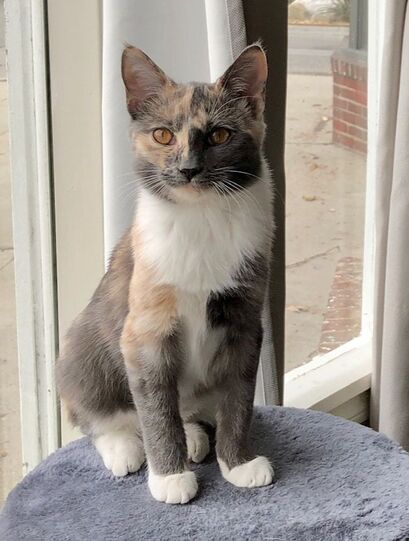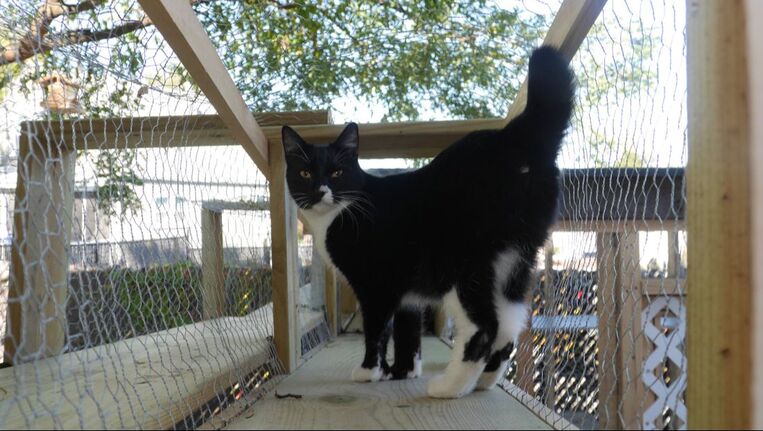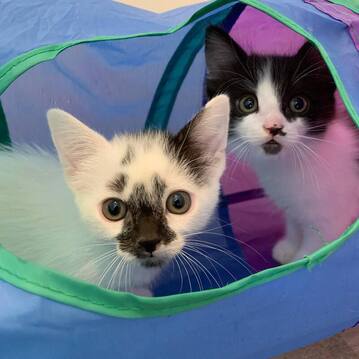Tips for Entertaining an Indoor Cat

Benefits for cats who live strictly indoors
Many animal guardians choose to keep their cats indoors for a variety of reasons. Indoor cats are protected from potential hazards such as predation, cars, diseases, fleas, ticks and cruel humans. Further, even street smart cats can get lost or picked up by animal control and end up in a shelter where they could be euthanized. It is estimated that only 2-5% of lost cats will be reunited with their guardian through shelters. Keeping a cat indoor significantly reduces the risk that the cat gets lost in the first place.
Risks for cats who live strictly indoors
Cat caretakers must take into consideration that indoor cats can sometimes suffer psychologically and develop behavioral problems. Dr. Nicholas Dodman of Tufts University School of Veterinary Medicine and Roger Tabor, British biologist and cat expert, both note that American cats sometimes have higher rates of anxiety-related problems, urinary tract problems, vomiting, weight issues and stress-related problems, which can be attributed to the indoor-only existence (Hamilton, 2010). Sadly, behavioral issues are the main reasons why caretakers relinquish cats to shelters; that’s why it is so important to provide entertainment and proper stimulation for indoor-only cats.
Signs your cat might be bored indoors
● Over grooming
● Chasing or fighting with other pets in the home
● Over eating or under eating
● Scratching furniture
● Litter box issues
The good news is that it can be easy and fun to keep your cat entertained indoors! Here are some tips:
Many animal guardians choose to keep their cats indoors for a variety of reasons. Indoor cats are protected from potential hazards such as predation, cars, diseases, fleas, ticks and cruel humans. Further, even street smart cats can get lost or picked up by animal control and end up in a shelter where they could be euthanized. It is estimated that only 2-5% of lost cats will be reunited with their guardian through shelters. Keeping a cat indoor significantly reduces the risk that the cat gets lost in the first place.
Risks for cats who live strictly indoors
Cat caretakers must take into consideration that indoor cats can sometimes suffer psychologically and develop behavioral problems. Dr. Nicholas Dodman of Tufts University School of Veterinary Medicine and Roger Tabor, British biologist and cat expert, both note that American cats sometimes have higher rates of anxiety-related problems, urinary tract problems, vomiting, weight issues and stress-related problems, which can be attributed to the indoor-only existence (Hamilton, 2010). Sadly, behavioral issues are the main reasons why caretakers relinquish cats to shelters; that’s why it is so important to provide entertainment and proper stimulation for indoor-only cats.
Signs your cat might be bored indoors
● Over grooming
● Chasing or fighting with other pets in the home
● Over eating or under eating
● Scratching furniture
● Litter box issues
The good news is that it can be easy and fun to keep your cat entertained indoors! Here are some tips:

Provide a window perch or catio.
The outdoors is basically cat TV. Buy a window perch or place a scratching post against the window so your cat can watch the outdoors. You can also create a whole outdoor patio or porch area for your cat. Make sure the catio is fully enclosed so she cannot escape. This allows her to see, hear, and feel the outdoors while staying safe. Also make sure no toxic plants are on or near the catio. (You can check out plants that are toxic to cats here.) Hang a bird feeder outside the window or catio; this makes the cat TV even more interesting and allows her to watch the local wildlife.
Provide interactive toys-
Playing with your cat is a great way to form or solidify a bond. Cat wands are an easy toy that you can make yourself and ones that can entertain your cat for hours. Laser pointers are also a cat favorite. Just make sure not to point the laser directly into the cat’s eyes. You can also buy battery-operated toys that will move around on their own and keep your cat entertained while you are gone. There are many battery-operated toys on the market including mice with wheels to move around the floor and string toys that sway back and forth.
-and self play toys - These are types that a cat can use on their own. There are a variety of battery operated toys, balls or even something as simple as a cardboard box! Check out your local pet store for many options.
Upcycle to your cats.
Oftentimes cats love the simplest and cheapest toys the best. Cardboard boxes and large paper bags are great options for cat toys; avoid plastic bags as they can be a choking hazard. Wad small pieces of newspaper and toss them to your cat for a fun game of baseball or hang old shoelaces from door knobs.
Make them work for their snacks.
If your cats love treats or catnip, a food puzzle can be a great way to encourage their natural hunting behaviors in a healthy way. Fill toys with treats, so cats have to figure out how to retrieve the reward.
Rotate cat toys.
If a toy is always around, your cat may become bored with it. Instead of having all toys out at once, rotate what toys are available for your cat to play with. This ensures that she is exposed to new and exciting things.
Use scratching posts and shelves to create vertical space.
Many cats feel comfortable up high. Create space for them to climb vertically for a fun way for them to play. Vertical space can also be useful in multi-cat homes where a cat may want a spot that provides her with more privacy. You can buy tall cat trees with differing perches or create a unique space using an old bookshelf and cat beds.
The outdoors is basically cat TV. Buy a window perch or place a scratching post against the window so your cat can watch the outdoors. You can also create a whole outdoor patio or porch area for your cat. Make sure the catio is fully enclosed so she cannot escape. This allows her to see, hear, and feel the outdoors while staying safe. Also make sure no toxic plants are on or near the catio. (You can check out plants that are toxic to cats here.) Hang a bird feeder outside the window or catio; this makes the cat TV even more interesting and allows her to watch the local wildlife.
Provide interactive toys-
Playing with your cat is a great way to form or solidify a bond. Cat wands are an easy toy that you can make yourself and ones that can entertain your cat for hours. Laser pointers are also a cat favorite. Just make sure not to point the laser directly into the cat’s eyes. You can also buy battery-operated toys that will move around on their own and keep your cat entertained while you are gone. There are many battery-operated toys on the market including mice with wheels to move around the floor and string toys that sway back and forth.
-and self play toys - These are types that a cat can use on their own. There are a variety of battery operated toys, balls or even something as simple as a cardboard box! Check out your local pet store for many options.
Upcycle to your cats.
Oftentimes cats love the simplest and cheapest toys the best. Cardboard boxes and large paper bags are great options for cat toys; avoid plastic bags as they can be a choking hazard. Wad small pieces of newspaper and toss them to your cat for a fun game of baseball or hang old shoelaces from door knobs.
Make them work for their snacks.
If your cats love treats or catnip, a food puzzle can be a great way to encourage their natural hunting behaviors in a healthy way. Fill toys with treats, so cats have to figure out how to retrieve the reward.
Rotate cat toys.
If a toy is always around, your cat may become bored with it. Instead of having all toys out at once, rotate what toys are available for your cat to play with. This ensures that she is exposed to new and exciting things.
Use scratching posts and shelves to create vertical space.
Many cats feel comfortable up high. Create space for them to climb vertically for a fun way for them to play. Vertical space can also be useful in multi-cat homes where a cat may want a spot that provides her with more privacy. You can buy tall cat trees with differing perches or create a unique space using an old bookshelf and cat beds.

Consider adopting another cat.
First, assess your cat’s personality to decide if they would do well with a buddy. Some cats may prefer to be the only cat in the home and adopting another cat can cause more stress. If your cat welcomes the company of other cats, adding a friend could be a great way for them to have companionship when you are gone. You also get to save another cat’s life which is a perk within itself!
Provide your cat with plenty of playtime when you’re home.
Play with your cat when you are home to release her energy. Work on tiring her out while you are home, so she’s less likely to be bored and more likely to relax while you are away.
Walk your cat!
Walking on a leash isn’t just a dog’s game. Cats can be trained to leash walk. Just keep in mind that each cat is different; some may take to walking on a leash rather quickly, while others may require longer training. Leash training is best done when the cat is young, so it becomes a familiar concept for your cat. Teaching your cat to walk on a leash can be a worthwhile way to engage her with the outside world.
First, assess your cat’s personality to decide if they would do well with a buddy. Some cats may prefer to be the only cat in the home and adopting another cat can cause more stress. If your cat welcomes the company of other cats, adding a friend could be a great way for them to have companionship when you are gone. You also get to save another cat’s life which is a perk within itself!
Provide your cat with plenty of playtime when you’re home.
Play with your cat when you are home to release her energy. Work on tiring her out while you are home, so she’s less likely to be bored and more likely to relax while you are away.
Walk your cat!
Walking on a leash isn’t just a dog’s game. Cats can be trained to leash walk. Just keep in mind that each cat is different; some may take to walking on a leash rather quickly, while others may require longer training. Leash training is best done when the cat is young, so it becomes a familiar concept for your cat. Teaching your cat to walk on a leash can be a worthwhile way to engage her with the outside world.